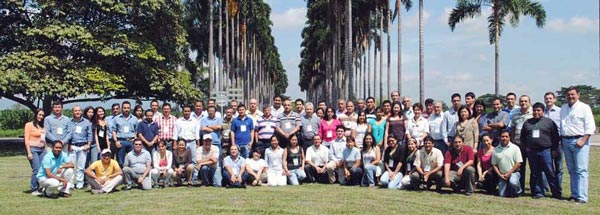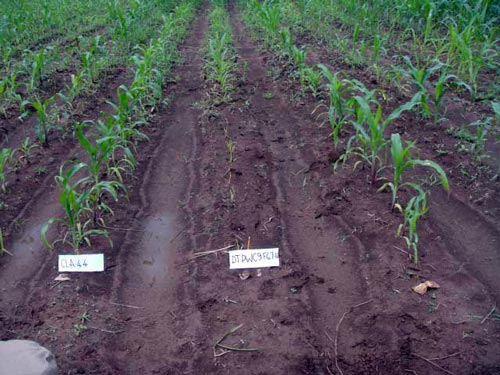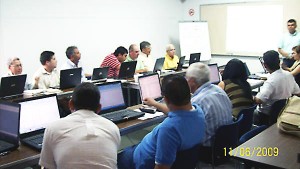Training, a golden rule at CIMMYT-Colombia
Training is a key CIMMYT activity, and in the CIMMYT-Colombia office it has been essential for all staff. During 08-11 November 2011, CIMMYT colleagues and partners took part in a course on analysis and interpretation of experiments, and genetic designs applied to breeding.
The course was attended by 75 plant breeders, biometricians, and molecular biologists, from a range of institutions such as Colombian and Ecuadorian research centers (CENICAÑA, CENIPALMA, CENICAFE, INIAP), guilds and private seed companies (FENALCE, FEDEARROZ, FEDEPALMA, Dow Agrosciences, Monsanto, Semillas Valle), Colombian universities, the International Center for Tropical Agriculture (CIAT), and CIMMYT. From the CIMMYT biometrics and statistics unit, consultant and University of Chapingo professor Mateo Vargas and researcher Gregorio Alvarado taught how to develop theoretical concepts of experimental designs and demonstrated the use of SAS, Genstat, ASREML, and R to analyze experiments.
Participants praised the course and requested similar courses and training events in the future. The course was organized by CIMMYT maize breeder Luis Narro and CIAT biometrician Myriam Cristina Duque, with funding from the Ministry of Agriculture and Rural Development of Colombia, as part of a collaborative project with the Colombian Corporation of Agriculture and Livestock Research (CORPOICA) and the Colombian National Federation of Cereals and Legume Growers (FENALCE).

CIMMYT-Colombia also fosters the professional development of support staff, through CIAT’s employees program. The CIAT fund for human resource development covers as much as half of employees’ training expenses, and they can pursue studies as long as they are able to keep up with their work. Thesis students also have time for research.
CIMMYT-Colombia wishes to recognize the efforts of Joel Bolaños, field worker, who has finished his elementary and secondary studies, and will soon start high school education. Néstor Romero, systems engineer, and Claudio Romero, business administrator, have graduated and will now study agronomy. Alba Lucía Arcos, research assistant, received an MSc in plant genetic breeding, and is now working on a PhD. Luz Karime Gómez, former administrative assistant, received an MSc and has since gone to study for a PhD in international relations in Spain.
 On 19 August 2011, a workshop was hosted by CIMMYT-Colombia for maize producers, association representatives, and educators and students from various local universities, among others, on the advances of a project to increase maize production in Colombia through the development of improved germplasm adapted to the production systems in the Orinoquía region (East Plains). The Orinoquía is an area of plains, covered by pasture and interspersed with rivers and forests; all the rivers terminate in the Orinoco river. The project is coordinated by CIMMYT-Colombia, with support from the Colombian Agricultural Research Cooperation (CORPOICA), Colombian Growers Federation of Cereals and Legumes (FENALCE), International Center of Tropical Agriculture (CIAT), and the Ministry of Agriculture and Rural Development of Colombia. The workshop took place at the CORPOICA Research Center in Villavicencio, Del Meta District.
On 19 August 2011, a workshop was hosted by CIMMYT-Colombia for maize producers, association representatives, and educators and students from various local universities, among others, on the advances of a project to increase maize production in Colombia through the development of improved germplasm adapted to the production systems in the Orinoquía region (East Plains). The Orinoquía is an area of plains, covered by pasture and interspersed with rivers and forests; all the rivers terminate in the Orinoco river. The project is coordinated by CIMMYT-Colombia, with support from the Colombian Agricultural Research Cooperation (CORPOICA), Colombian Growers Federation of Cereals and Legumes (FENALCE), International Center of Tropical Agriculture (CIAT), and the Ministry of Agriculture and Rural Development of Colombia. The workshop took place at the CORPOICA Research Center in Villavicencio, Del Meta District. About 20 scientists from
About 20 scientists from